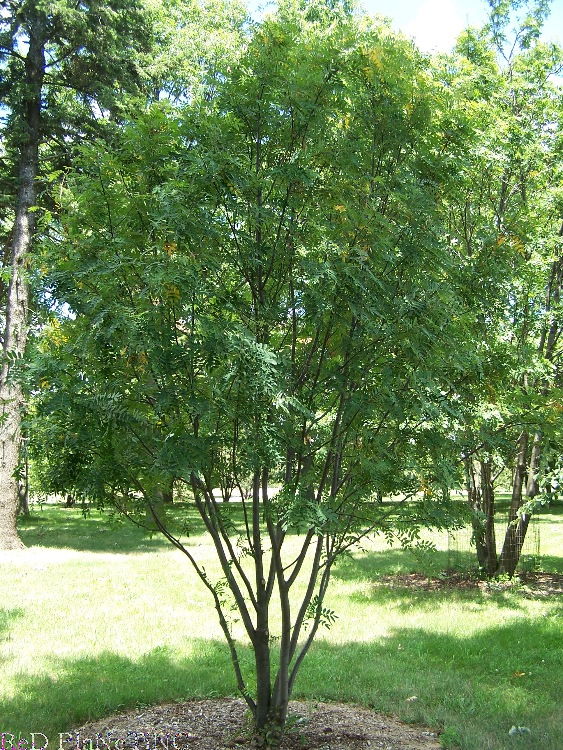Hupeh Mountain-Ash – Sorbus hupehensis
This compact tree’s delicate, fern-like foliage makes an ideal ornamental for gardens and specimen plantings.
Pinnate leaves, up to 15cm long, each with up to 15 ovate, blue-green leaflets turn a vivid scarlet red in autumn. In spring corymbs of white flowers are borne from which the spherical fruit form later, initially white before ripening to dark pink. (1)
Compact medium-sized deciduous tree with leaves composed of about 11 oblong, blunt, bluish-green leaflets. Creamy-white flowers followed by rosy-pink or white fruits. Sorbus hupehensis grows best in moderately fertile, humus-rich soil that is moist but well drained and slightly acidic.

Hupeh Mountain-Ash, is 12 years old
It needs full sun but does not like intense heat and should be watered well and mulched during periods of dry weather. Pruning, if necessary, should be done in early spring or winter. Tolerant of atmospheric pollution, and suitable as specimen trees in small gardens in the city. They are also ideal for wild or woodland gardens [1].
The Sorbus genus covers about 190 different species of deciduous trees and shrubs, found mainly in northern temperate regions, in woodland, on hills, mountains and on scree. Sorbus species and cultivars are prized for their ornamental qualities. Their leaves are decorative, and may be either simple or pinnate, and often color well in autumn.
The mountain ash and related species (most often the European Mountain ash, Sorbus aucuparia) are sometimes referred to in folklore as “Rowan” trees, but this use has almost disappeared from the modern lexicon. The rowans were thought by the Celts and other primitive peoples of The British Isles to have magical properties.
“Mountain ash, 1804, from prowan-tree, rountreep (1548), northern English and Scottish, from a Scandinavian source (cf. O.N. reynir, Swed. Ronn “the rowan”), ultimately from the root of pred, in reference to the berries. The rowan “was the tree most often credited with protective magical powers against all effects of witchcraft, not merely in Celtic areas but throughout Britain.” — Oxford Dictionary of English Folklore
References
1. Royal Horticultural Society Plant Selector, (1)
2. Hupeh Mountain-Ash, Morton Arboretum accession photos by Bruce Marlin
3. University of Michigan, Native American Ethnobotany
Tree Encyclopedia / North American Insects & Spiders is dedicated to providing family-friendly
educational resources for our users through use of large images and macro photographs of flora and fauna.

